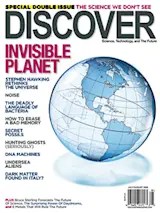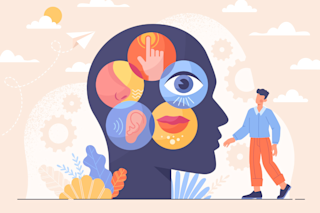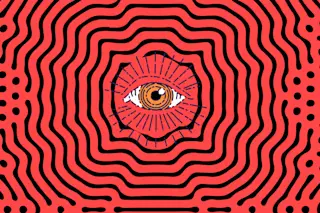We live in a sonic world, immersed in vibrations that stimulate microscopic hair cells deep inside our ears. This unseen energy influences our mood, our learning, even our health. We experience it as comforting music, as information-laden speech, or—all too often—as irritating noise, a by-product of our increasingly mechanized world. Despite all the ways sound affects us, we often let it slip unnoticed into the background of our lives. Hoping to understand it better, I set out to explore the mysteries of sound in the course of one day.
At 6:50 a.m., my alarm clock begins the assault on my ears as the groggy gray matter between them is rudely yanked toward consciousness. My eyes shoot open, and as awareness slowly crystallizes, a single idea crowds out all others: Make the noise stop. My right hand knows just what to do and immediately puts an end to the awful blare.
The formal term for the unpleasant shock that jolts me awake is acoustic startle response. Loud, sudden noises can trigger movements involving the limbs, torso, and eyelids, as well as increases in heart rate and blood pressure. This stress reaction comes in handy when noise indicates danger from, say, a wild animal or a deadly explosion. It is less useful when the enemy is a clock.
The rapid movement of an object (such as the speaker in my clock) throws surrounding air molecules into a frenzy. That disturbance produces waves of high and low pressure traveling at about 760 miles per hour, which we experience as sound.
At the receiving end, the outer ears collect the waves’ energy, causing vibrations in the tympanic membrane—the eardrum. The membrane wiggles the three middle-ear bones, which transmit fluctuations to the fluid-filled, snail-shell-shaped cochlea of the inner ear. Inside this chamber, delicate hair cells relay the sound to the auditory nerve, which carries electric signals to the brain, where they are interpreted as a familiar voice, an expressive instrumental melody, or the jarring beep that starts my day.
Our perception of loudness is subjective, but sound has an intensity, independent of our hearing, that is measured in decibels (dB). Throughout this story, decibels are measured using a dBA filter, which closely matches how the human ear absorbs sound. (Acousticians sometimes use other scales, such as dBC, which includes low and very high frequencies that human ears cannot register.) On the dBA scale, 0 dB corresponds with the threshold of hearing (10-12 watts/square meter), the level that can just barely be detected by most people. The quiet inside a sound-insulated recording studio registers around 20 dB, while a loud telephone ring is about 70. A jet engine or loud rock concert can hit 120 dB, sometimes described as the threshold of pain for our ears. The U.S. Army Medical Department ominously lists 180 dB as the threshold of death, the point at which sound can cause fatal injuries. Pressure waves generated by explosions or weapon noise, for instance, can rupture air-filled organs, such as lungs.
Shortly before 8 a.m., as I stand on the platform awaiting my commuter train to Manhattan, I pull out a sound-level meter. Vehicle traffic is light, and the most conspicuous noise emanates from a cooling unit on the station roof. The sound level hovers around 64 dB but bumps up to 75 dB as the train approaches.
Once in the city, the subway ride downtown from Grand Central Terminal does not seem loud, but the deep rumbling hovers above 75 dB, peaking at 86 dB, when joined by a large group of 7th graders on a field trip. At 14th Street, where I exit, the high-pitched squeal of arriving trains is excruciating. My sound meter registers 95 to 98 dB—above my personal threshold of pain, apparently. Psychoacoustician William Hartmann, who studies sound perception at Michigan State University, says that the high-pitched sound of the subway probably has components in the range of 3,000 to 4,000 hertz (Hz), or vibrations per second. Such frequencies transmit efficiently to the inner ear. “Brakes tend to have a pure-tone sound with only a few frequencies contributing to the power,” Hartmann says. “By contrast, the rumble of the train is broadband—lots of frequencies. Intense pure-tone sounds are more annoying.” I escape the subway and walk into DISCOVER’s lobby a few minutes before 9 a.m., relieved to measure a peaceful 55 dB, the quietest reading of the day so far.
Habitual exposure to sound levels of 85 dB or above will cause hearing loss for many, according to the American Hearing Research Foundation. Loud sounds put too much pressure on the cochlear hair cells, which can damage or kill them. Once dead, they do not regenerate, so hearing is permanently affected. One in 10 Americans has hearing loss, including more than one in three over the age of 65. Impairments range from an inability to hear certain frequencies—for example, the high frequencies of women’s and children’s voices—to complete deafness. On the bright side, the World Health Organization (WHO) estimates that 50 percent of deafness and hearing impairment is preventable. Newly sensitive to the dangers of my loud morning, I stop by Manhattan’s Center for Hearing and Communication for a screening. Director of audiology Ellen Pfeffer Lafargue administers a series of beeps, ranging from 500 Hz to 4,000 Hz, and asks me to respond to each. She soon reassures me that my hearing is within the normal range. That does not necessarily mean it has not deteriorated, though. Young adults can pick up frequencies ranging from as low as 20-Hz bass notes to 20,000-Hz squeaks. But as we age, we tend to lose some of our high-frequency hearing. For most people, peak sensitivity occurs for frequencies around 1,000 to 4,000 Hz.
Curious whether I still have my full high-frequency range, I check out an informal Web-based hearing test from the University of New South Wales. To my surprise, I can make out the lowest (30 Hz) and highest (16,000 Hz) pitches. But in another batch of online tones that includes even higher frequencies, I hear nothing at 18,000 Hz or above. In comparison, dogs can hear up to 45,000 Hz and mice to 91,000 Hz. Bats top out at 110,000 Hz, while dolphins and porpoises can reportedly detect frequencies at 150,000 Hz.
The surrounding bath of urban sound has mental as well as physical effects, according to environmental psychologist Arline Bronzaft, who has spent more than 30 years studying how people perceive and respond to noise. Currently with the Council on the Environment of New York City, she has addressed noise problems as diverse as a neighbor’s too-loud TV, the banging of a bed during sex, and a mysterious whistling in the middle of the night that disturbed Brooklynites in the 1990s. (It turned out to be a signal used by a ring of drug dealers.) I stopped by Bronzaft’s home on the Upper East Side to learn more about why noise matters. As we sat among bookcases filled with decades of research, she explained that not everyone reacts to noise the same way, but the negative effects of unwanted sounds on health are real and measurable. Even soft noises, well below the level that can damage hearing, have been linked to stress and cardiovascular disease. “A sound that is interpreted as noise, as something we don’t want to hear, causes stress,” Bronzaft says, “which causes problems with the heart, the gut, and other organs.”
Bronzaft pioneered studies that show noise can impede children’s learning. Following up on a complaint that a school was near a loud train track, Bronzaft compared the performance of students in the half of the building facing the tracks with that of the children in the quieter part of the school. She found that sixth-graders in the noisy classrooms were about one grade behind their peers in the quieter section on reading scores. The year after the Metropolitan Transit Authority installed rubber pads under the rails to lessen the noise, reading scores at the school evened out. Bronzaft says that more than 30 studies have subsequently documented the impact of noise on learning.
Noise may even contribute to violence, says Bronzaft, recalling the recent case of a firefighter in Cleveland who was kept awake by firecrackers one Fourth of July night. He asked the neighbors to keep things quiet, but when the noise continued, he retrieved a gun and opened fire, killing three people. “Do I think that what he did was right? Absolutely not,” Bronzaft says. “But can I understand the anguish he might have been going through with that noise? I think I can.” The WHO identifies aggressiveness as a health risk of noise, and the United States was an early leader in recognizing the dangers related to noise. The Noise Control Act of 1972 stated “it is the policy of the United States to promote an environment for all Americans free from noise that jeopardizes their health or welfare.” Although the act remains on the books, the Environmental Protection Agency’s Office of Noise Abatement and Control lost its funding in 1982. No federal agency, Bronzaft says, is properly enforcing the law today.
With all that in mind, I seek out what should be one of New York’s most peaceful spots: the Rose Main Reading Room in the New York Public Library. Dozens of patrons read and work quietly there, but the room’s resonance makes the smallest noises irritatingly noticeable. The scuffling of chair legs, flipping of pages, and zipping of backpacks all stand out. Still, my sound meter moves between 52 and 55 dB, the softest readings yet, and a far cry from the 70 and 75 I registered just outside on the busy corner of 42nd Street and Fifth Avenue.
Next I seek refuge from the city’s clamor in Central Park, but here too the noise is inescapable. As I approach, a jackhammering construction crew works near 66th Street—registering 90 dB and remaining audible for several blocks. Further into the park, at the Arthur Ross Pinetum, birdsong finally is the most noticeable feature of the soundscape. Standing next to the pines, I register 55 dB, but the relative calm is broken by a plane passing overhead at 80 dB.
There may be no one more frustrated by the encroachment of man-made noise on the natural world than Gordon Hempton, an acoustic ecologist in Port Angeles, Washington. For nearly three decades, Hempton has been recording the sounds of nature and documenting the steady erosion of natural quiet (chronicled in his new book coauthored with John Grossmann, One Square Inch of Silence).
“There are no places left on earth that are free of human-caused noise 100 percent of the time. That’s history,” Hempton says. “What we now use as a measure of quiet is the noise-free interval: How long is it quiet without an intrusion?” In 1984 he identified 21 areas in Washington state where the noise-free interval was 15 minutes or more. Today just three remain. “Olympic National Park is one, and the other two are protected only by their anonymity,” he says. By Hempton’s reckoning, there are fewer than a dozen such places in the entire United States, and there are none in Europe. Currently in most of our national parks, the daytime noise-free interval is five minutes or less.
While natural sounds in the wilderness are threatened, some researchers are bringing them indoors to relax stressed-out humans. A study in Japan found that patients who listened to nature sounds during surgery emerged from general anesthesia more smoothly than a control group who heard the procedure; the latter experienced significantly higher heart rate and blood pressure while returning to consciousness. Another study, at Johns Hopkins University, found that patients who viewed nature scenes and listened to natural sounds during bronchoscopy reported less pain than those who did not.
Music is another form of therapeutic sound, relieving anxiety, improving mood, and lessening pain. Last year, researchers in Finland and Canada found that patients in the early stages of stroke recovery who listened to their choice of music experienced improved verbal memory and attention compared with patients who listened to audio books or no recordings. And in March of this year, neuroscientists in the U.K. and Spain reported that stroke patients with vision problems experienced greater visual awareness while listening to music they liked compared to “unpreferred” music or none at all.
One of New York City’s most interesting sound labs is not a lab at all: Alice Tully Hall, the most heavily used venue at Lincoln Center. The hall has hosted world-class musicians since its opening in 1969, but as its mahogany walls aged, it began to grow “acoustically dry,” says Ron Austin, Lincoln Center’s executive director of development. “The primary sound from an instrument or vocalist is only one component of what we hear. There’s also a primary reflection, which bounces off of one surface before reaching the listener, and the secondary reflections that bounce off of two,” Austin says. “When the materials and angles are right, these reflections create a cocoon of sound. But if the space is too absorptive, you don’t get that.”
To enrich Tully Hall’s acoustics, Lincoln Center turned to the acoustic consulting firm JaffeHolden. “Working with the architects and designers, we suggested modifications to improve the sound,” says principal acoustician Mark Holden. “We created these wall shapings, or panels, on the side walls, and picked angles carefully. And we selected materials [wood and resin] to be efficient reflectors of sound energy. The whole shaping and structure was designed to give the sounds more brightness and clarity.” The multilayered resin and wood veneer were mounted on thick rubber pads to minimize vibrations from the subway that runs right next to the building. And while renovations were underway, the Metropolitan Transit Authority helped out by welding all of the subway track within a thousand feet of the hall and mounting it on rubber pads to reduce noise.
When I visit Lincoln Center, I find noise up to 80 dB on the street corner outside, but after I step into the empty Tully Hall and close the door behind me, my meter bottoms out at its lower limit of 50 dB for the first time; Holden tells me his firm’s measurements show that the sound level in the space is actually less than 25 dB. “It’s one of the few really quiet rooms in the whole city,” he says, “a place where you can hear subtleties.” Reviews of Tully’s reopening in February celebrated its “heavenly acoustics,” calling it a place where sounds “shimmered” and “carried beautifully.”
Back home finally, I review the lessons of the day before heading off to sleep. I make a sound resolution: Pick up a new alarm clock, one that puts more music and less stress in my life.














